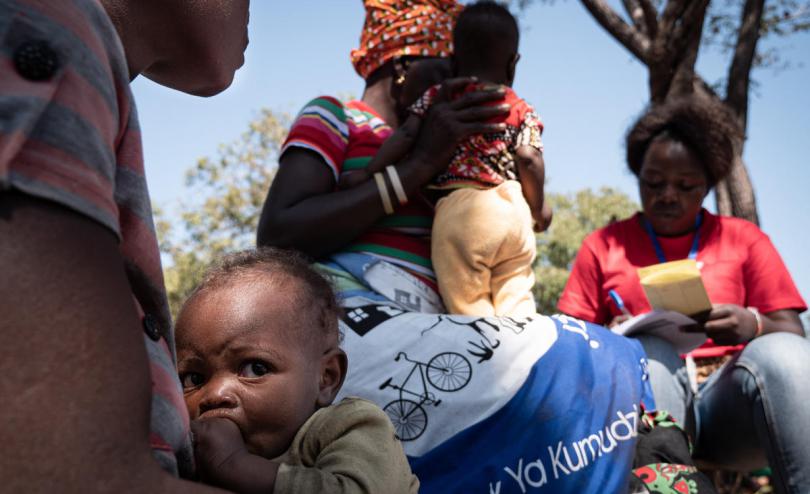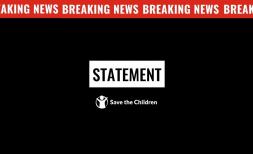Six months on from Cyclone Idai, survivors fear “dying from hunger”

Thousands of families are suffering severe food shortages six months after Cyclone Idai tore through central Mozambique, says Save the Children. The agency has spoken to several survivors, who are still living hand to mouth following the destruction of their homes and livelihoods.
Cyclone Idai hit Mozambique on 14 March, killing 603 people and injuring 1,641 [i]. The country was struck by another devastating cyclone, Kenneth, on 25 April and was then hit by drought.
The combined crises have destroyed crops, seeds and devastated people's means of living, pushing children and their families to and over the edge of hunger. An estimated 3,000 sq. km of land were flooded in Cyclone Idai alone, with over 715,000 hectares of crop fields under water and widespread damage to key infrastructure. Mud and sand still covers large swathes of land, making it impossible to farm, and there is a severe lack of seeds for the next, critical harvest. At least 433,056 households have had their land and crops partially or totally destroyed [ii].
As a result, nearly 2 million people in Mozambique are expected to be severely food insecure in the coming months, more than twice the number in the same time last year [iii]. The lack of food has serious health implications, with an estimated 67,500 children are already suffering from acute malnutrition and need treatment [iv].
Save the Children is warning that unless families in the hard-hit areas receive support, more cyclone-children will struggle to survive. Children are at particular risk of exploitation, with many boys and girls still out of school, girls at risk of violence during their long walks to collect water, and boys at risk of being forced into work [v].
Save the Children is calling on international donors to commit an additional US $160 millionvi to ensure families receive adequate food and children are protected.
Grandmother Maria (40) and her daughter-in-law Regina (35) lost their homes and crops in Cyclone Idai, and are now jointly caring for orphaned twin babies, Luisa and Franque. In July, Franque was diagnosed with moderate acute malnutrition, and both babies have suffered diarrhoea, malaria and the flu in the past six months.
Maria said:
"Now we are dying from hunger, all of us in the tents are dying of hunger... We don't have anything for us to eat...There in some people's farms there are bits of rotten corn, which we collect and peel them and grind them. The government helped us a lot here and even till now they are helping but now we are dying from hunger."
Albertina (33) lives with her five children in a resettlement camp. During the cyclone and the floods that followed, Albertina and her family lost most of their belongings, including crops and food. Albertina said:
"The biggest problem that is worrying us is food, things to eat are very scarce... We cook our food without oil... Before the cyclone we were farmers, we had bananas, we sold our bananas for our survival. We cultivated sesame and we sold it as well as maize, even vegetables and onions, we sold them, that's what helped us a lot, goats, and chickens to sell. But all of these things we don't have anymore."
Save the Children's Country Director in Mozambique, Chance Briggs, said:
"We're seeing recovery funds dry up just as people need them the most. Getting your life back together after you lose everything takes time. Six months on from Idai we are seeing families unable to earn cash because their crops have been destroyed, and sand and mud have overflowed the land they used to work. Many children are still out of school, leaving them vulnerable to exploitation, child labour and early marriage.
"While the destructive effects of climate change will be discussed at the UN Climate Change summit later this month, Mozambique is already suffering the harsh reality of erratic weather patterns. It is critical that donors use this opportunity, six months on from one of the most devastating natural disasters to strike this region, to commit new funds to support the recovery. The response has only been 50% funded to date, with these funds largely committed in the immediate aftermath of the cyclone [vi]. More is needed, urgently, to get families back in a position where they can look towards the future with hope."
Save the Children was among the first actors to respond to Cyclone Idai and reached over 400,000 people with humanitarian assistance to date. Our Emergency Health Unit has delivered life-saving healthcare for impacted children and families in the four affected provinces of Manica, Sofala, Tete and Zambezia. Blankets, mosquito nets, buckets to store clean water and solar lights are still being distributed to families. To ensure children don't miss out on months of learning, our education team has been assessing damaged schools for repairs, constructing temporary learning spaces and replacing school supplies to get classes underway. To support the emotional wellbeing of children who have suffered loss or separation from a loved one, we have established child-friendly spaces in shelters.
Save the Children is a member of the COSACA consortium, which has jointly reached close to a million people with assistance till date. Through COSACA, seeds and tools distributions are scheduled to take place assisting people with food production and a successful next harvest. Save the Children is working in close coordination with the government and the National Institute of Disaster Management to support children impacted by the disaster.
- Government of Mozambique Situation Report (August 2019) https://reliefweb.int/sites/reliefweb.int/files/resources/SitRep%208_MOZ_15%20%20to%2028%20Jul%202019_ENG.pdf
- Government of Mozambique (2019). Mozambique Cyclone Idai Post Disaster Needs Assessment. https://www.undp.org/content/undp/en/home/librarypage/crisis-prevention-and-recovery/mozambique-cyclone-idai-post-disaster-needs-assessment--pdna-dna.html
- MOZAMBIQUE Vulnerability Assessment Committee Results 2019 https://reliefweb.int/sites/reliefweb.int/files/resources/SADC_Mozambique_snapshot_July2019.pdf
- In the projection period from October 2019 to February 2020, it is expected that this number of people could increase to 1,994,538 if there are no humanitarian interventions and taking into account that this is the lean season [IPC July 2019] https://reliefweb.int/sites/reliefweb.int/files/resources/IPC_AFI_AMN_Mozambique_2019April2020Feb_English.pdf
- Referenced in [ii]
- UNOCHA Funding Tracker shows Total funding needs to the emergency in 2019: US$329.8m; total funding received: US$157.4m; and unmet requirements: US$160.4m https://fts.unocha.org/emergencies/808/summary/2019
- Referenced in [vi]




